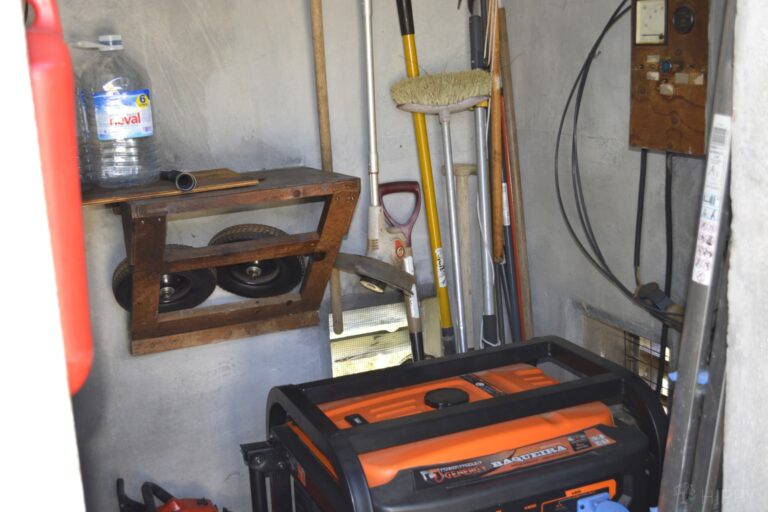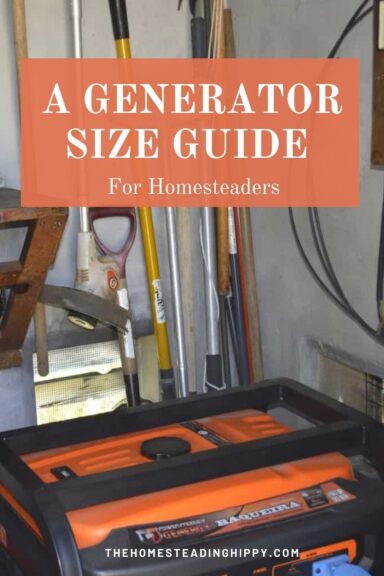Having a reliable generator is important if you want to keep your homestead running through thick and thin. A good genny will help you keep the lights on in the aftermath of a bad storm, or take care of work far out on your property when extension cords just won’t reach.

But there are so many different sizes and types of generators out there that it can be downright intimidating trying to figure out how much capability you need. So, how can you know what size generator is right for you?
Determining what size generator you need is a matter of analyzing your power requirements and desired level of comfort when relying on the generator.
This can be done by calculating the needed wattage of appliances and fixtures, using a calculator app, or looking at historical electrical usage on your property.
It’s really not too difficult to figure out correctly how much power you’ll need and for what purpose, but you’ve got to do some homework and double-check it…
Having two smaller generators, or even one that is too big, can cause problems and maybe even damage. Keep reading, and I’ll tell you everything you need to know.
Why Picking the Right Size Is So Important
Simply put, it’s because you need enough generator to run the things you need to, and want to, without consuming too much fuel and without overloading the unit itself. This, as you might imagine, can certainly be a balancing act!
A generator that is insufficient for the task at hand will lead to a loss of, or unreliable power output, meaning you’ll experience brownouts, blackouts, and potentially catastrophic loss of capability.
Freezers, refrigerators, and other appliances that fail can lead to spoiled food and other bad outcomes! If your generator is overtaxed, it can also cause overheating, damage, or potentially even self-destruct…
Conversely, a generator that is too large is only going to waste fuel and be inefficient, at best. That will cost you more money in the short term and the long term since these larger generators are invariably so much more expensive than their smaller counterparts.
Worse, and particularly in the case of whole house generators, they can cause direct damage to your electrical system and connected appliances or devices.
Sure, it’s a lot easier to just pick one that you think is best or pick one that is a lot bigger than you know you’ll need and go with it, but spending just a little bit of extra time to choose wisely will make a big difference at the end of the day.
Do You Need Full Capability or Just the Basics?
The first thing you need to figure out when it comes to performance is how much capability you need:
- do you want total comfort and maximum capability, meaning you can run every single light, appliance, and gadget in your home,
- …or just enough to handle the basics like one or two major appliances, or even just some power tools and a few lights or countertop appliances?
This is a fundamental question that will inform every other choice you make when shopping for and eventually purchasing your unit.
Portable vs. Whole-House Generators
Obviously, a whole-house generator will have dramatically more power output than a portable one, and will cost proportionally more.
These are typically installed on a dedicated pad that is immediately adjacent to your house or sometimes in a small generator shed that will give it protection from weather and other incidental damage.
Note that because these are essentially built into the house and not explicitly portable, you need to place a whole house generator so that it is protected from flooding, groundwater, and other hazards.
Smaller job site generators are cheap, mobile, and can still take care of what you might call basic life support in the home during a power outage, but you’ll have to choose what you want to run carefully and potentially even stagger the startup of various gadgets and appliances.
That said, it is sometimes possible to use a special installed connection point in the home to plug in the generator directly to the structure’s electrical system, meaning you can use its switches and other appliances normally…
What Different Generators Can Run
So what should you actually expect from a given generator? When you look at the advertised output of any given manufacturer’s models, what does that translate to?
The following range will give you an idea of what the different classes of generators can do for you.
4,000 to 10,000 Watts
Most small, portable generators of the kind you’ll typically see on job sites fall within this range and are capable of running several lights at a time along with chargers for personal electronics and other gear like laptops, tablets, and the like.
They can also run a typical refrigerator-freezer combo, depending on its size and efficiency, and a few modest drain countertop appliances like coffee makers.
10,000 to 14,000 Watts
You’re getting into some serious output with generators in this range. These can run everything that the previous class does, and run more of those things simultaneously.
You’ll also be able to run:
- televisions,
- monitors,
- PCs,
- space heaters,
- electric stove tops or griddles,
- small air conditioning units,
- water heaters – though these high-drain devices cannot necessarily be run simultaneously.
18,000+ Watts
The largest and most capable class of generators that are typically encountered for residential use. Once again, these will handle everything in the previous two categories, with multiple high-drain devices simultaneously being no problem.
It can also run larger air conditioning units, electric water heaters, and the most intensive appliances like washing machines, electric clothes dryers, dishwashers, etc.
Figuring Out What Size Generator You Need
So all that’s very interesting, but how do you figure out how much power you really need from your generator?
You’ve got a couple of ways to go about it:
Use a Calculator
Many manufacturers have guided-use tools online to help you figure out exactly what generator will best fit your needs. There’s no shame in using them!
Measure Peak Consumption in Real Time
One of the most informative methods for figuring out how much juice you need is to simply use an ammeter hooked up to your electrical service when you have all of the devices and lights running that you want to run off of your generator.
Once you know how many amps are used, you can do a simple calculation that is the total amps multiplied by the supply voltage to figure out the load in watts.
Also, don’t forget to add the wattage requirements of any standby or emergency equipment that will activate under various conditions if you want the generator to run them: Alarms, sensors, sprinklers, etc.
Once you know what the final load is you can shop for a generator accordingly based on its known output.
Check Yearly Usage Records
Call your power company and review your bills month over month to figure out what the peak demand is and when.
A good rule of thumb is to increase your determined peak consumption by 15 to 25% to account for intangibles and unforeseen circumstances. And, sadly, also the fact that most generators cannot output their absolute maximum listed power at a sustained level indefinitely!
Don’t split hairs in this regard! It’s better to have a slightly more capable generator and not risk brownouts rather than pinch pennies and endure them.
Calculate Consumption for Appliances and Fixtures
The traditional way to figure out the size of the generator you’ll need is to calculate the consumption for all of your needed, or just wanted, appliances, lights, and other fixtures by looking up their operating wattage requirements.
Usually, this info will be on the manufacturer’s info placard, on the box, or in the manual depending on the item in question. All you need to do, simply enough, is add all of those things up to get a final tally and then purchase a generator accordingly.
Still, the running wattage of all of your appliances and fixtures isn’t the final answer, as you’ll need to account for surge or starting wattage. See the next section.
Don’t Forget to Account for Starting Watts!
No matter what method you’re using, you mustn’t forget to account for the starting or surge watts of your appliances.
This is an increased power demand needed to start up motors, fans, and other components that are built-in, typically found on refrigerators, freezers, things that use capacitors, and so forth.
Often, these surge wattage requirements are anywhere from 3 to 6 times as high as the running watts!
Most appliances require nowhere near as much power to keep them running once they are started, but starting them might cause an overload or even total generator failure!
It is because of surge wattage that you’ll need to often stagger turning on larger appliances when running your genny…
For instance, you might need to turn on the refrigerator at first and then let its power demand settle down to its normal running load before you turn on an air conditioner, repeating the process and then turning on your steady, constant drain devices and fixtures last.
The more powerful your generator is, the less you’ll have to be concerned about staggering your startup.
Again, this info can be found in the manual and sometimes on the placard of larger appliances. If in doubt, you can usually look this info up online but make sure you account for it.

Tom has built and remodeled homes, generated his own electricity, grown his own food and more, all in quest of remaining as independent of society as possible. Now he shares his experiences and hard-earned lessons with readers around the country.
Find out more about the team here.
